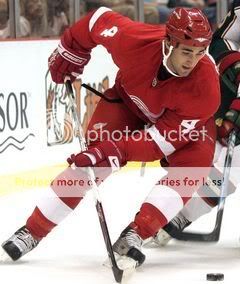Ha, I didn't even have to Photoshop this
So we meet again. After being claimed off waivers in 2008, Kyle Quincey is back with the Red Wings. This time around more will be expected of Quincey, especially after the former 132nd overall pick and pending RFA cost a first round pick in return. I had no idea Quincey was even on the radar so there's no Trade Deadline Targets post for him, but how are we supposed to know what the Wings are really getting without some statistical analysis?
Numbers? Numbers!
How was Quincey being used in Colorado? His Relative Corsi Quality of Competition was third on the team at 0.243, while the two highest Avs were at 0.694 and 0.612. In terms of even strength time, Quincey was second on the team with 16.74 minutes per 60. The Avs were clearly using Quincey as a second pair defenseman when the team was at even strength.
Even-strength scoring wasn't exactly Quincey's strong suit, but in all fairness that really isn't a strength of Colorado's as a whole. The team leader for players who've played over 50 games was Jan Heda with 0.80 points per 60 minutes of even strength play. Quincey is averaging 0.14 goals, 0.20 1st assists, and 0.20 2nd assists for a combined average of 0.54 points per 60 minutes of even strength time.
When Quincey was on the ice the Avs averaged 2.30 goals for per 60 minutes and allowed 2.64 goals per 60 minutes at even strength for a total +/- of -0.34 per 60 minutes. At first glance this is pretty ugly, but when Quincey is off the ice Colorado averaged 1.80 GF/60 and 2.48 GA/60 for a total +/-/60 of -0.67. By comparison, Quincey looks strong.
One thing to look out for is Quincey's propensity to take penalties. At even strength he's averaging 1.5 penalties per 60 minutes, while only drawing 0.3 penalties per 60 minutes.
Quincey's offensive numbers pick up on the powerplay, but he still has a bad habit of taking penalties too frequently. He's averaging 0.98 G/60, 0.00 1st assists/60, and 2.45 2nd assists/60 for a total of 3.44 pts/60. He's been on the ice for 16 powerplay goals, one behind Erik Johnson's team leading 17. All of this is done with 2.31 powerplay minutes per 60 minutes played. Quincey's on-ice goal differential +/-/60 is 7.30, which is much better than the Avs fair when Quincey is off the ice (goal differential +/-/60 of 6.71). This indicates his importance to their powerplay unit.
As for the penalties, he's averaging 1.5 penalties taken per 60 minutes, and drawing 0.5 penalties per 60 minutes. On the powerplay. Yeah. Not so good.
On the penalty kill, Quincey is averaging 2.31 minutes. His Relative Corsi Quality of Competition is 2.965, close to the 3.333 that leads the Avs. He's playing against good players, and he's playing substantial minutes on the PK.
So...is he good?
He's definitely good, and I'll admit that he's better than I thought he was. Maybe it's lingering hesitation because this was a guy that was once waived, but he's clearly improved since then. Quincey will come into Detroit and be a tremendously solid 3rd pair d-man with an offensive upside. If he works on his bad habit of taking too many penalties then this could be a great future 2nd pair guy. Detroit made another shrewd move to get back a player they wished they hadn't let go in the first place.
As always, the statistics in this article come from behindthenet.ca

No comments:
Post a Comment